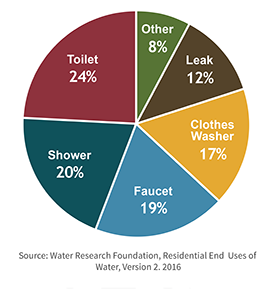Water Conservation
In the United States, access to clean, safe drinking water is something we largely take for granted. Yet water scarcity is affecting many parts of the country, while demand continues to increase. This is leading to water stress, which you can learn more about on our Environment and News pages.
Water stress makes water conservation at home more important than ever, because the adage “every drop counts”, really is true when millions of our neighbors are experiencing the same thing.
Local Watering Restrictions in Effect
St Johns River Water Management District
The district covers all or part of 18 counties in northeast and east-central Florida.
Counties entirely in the district are Brevard, Clay, Duval, Flagler, Indian River, Nassau, Seminole, St. Johns and Volusia. Counties partially in the district are Alachua, Baker, Bradford, Lake, Marion, Okeechobee, Orange, Osceola and Putnam.
This map shows the district and its counties, major cities and major water bodies.
St Johns River Water Management District Watering Restrictions in Effect
The St. Johns River Water Management District’s watering restrictions are designed to ensure the efficient use of water for landscape irrigation. The restrictions allow enough water to maintain healthy landscapes year-round.
The mandatory restrictions specify the time when watering may occur, the amount of water that may be applied, and the days when watering may occur for residential and nonresidential locations.
These days depend on whether the address ends in an odd or even number, and on the time of year.
Watering Restriction FAQs
Irrigation Schedule for Efficiency
| Time of Year |
Homes with odd numbered or no addresses |
Homes with even numbered addresses |
Non-residential properties |
| Daylight saving time |
Wednesday/Saturday |
Thursday/Sunday |
Tuesday/Friday |
| Eastern Standard Time |
Saturday |
Sunday |
Tuesday |
Please visit the St. Johns River Water Management District website for more information about local watering restrictions.
How Can I Conserve Water?
All of us can make wise water choices to conserve water (and save money) every day. And once these become habit, they require very little thought or effort. The tips below are a start, and the US Environmental Protection Agency's (EPA) WaterSense website has plenty more.
Additionally, periodically checking your home plumbing system for leaks will ensure you’re not simply wasting water. This can potentially save you hundreds of dollars on your annual water bill.
How Does My Household Compare?
Knowing how your water use compares to average consumption is a first step to conserving water and making improvements.
How Much Water Do We Use?

According to the Water Research Foundation, the average American family home uses about 300 gallons of water per day. Roughly 70% of that is indoors and 30% outdoors. Naturally, outdoor use varies greatly by region and type of home.
How Do I Measure My Consumption?
The most accurate way to understand your water consumption is by looking at the consumption tables on your water bill or My Utility Account. These will help you track monthly use and compare it to previous periods. Has your water use been increasing? Is this something you can explain, or have household habits changed? Or perhaps you have a leak. There's an easy way to test for leaks in your system using your Water Meter.